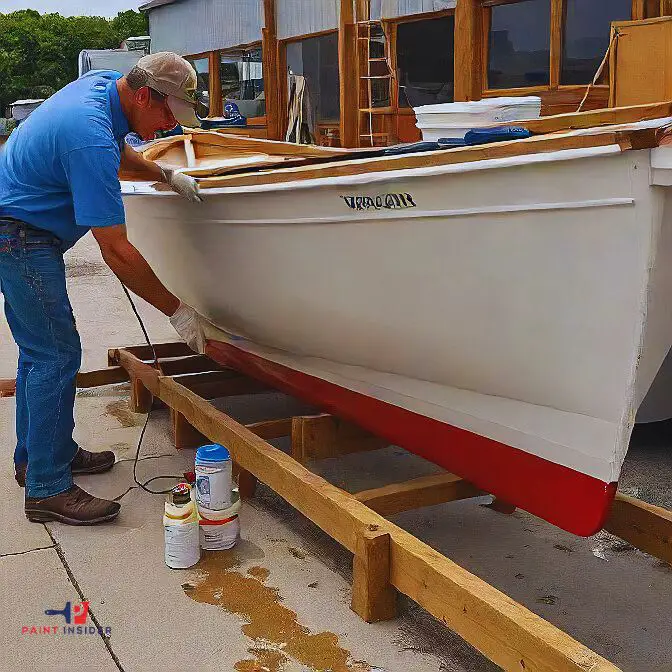Doing paintwork on a vessel is not a walk in the park, and it is crucial to learn all that is there to learn about how to paint a boat hull, and more specifically, how to paint a fiberglass boat hull. The information we have shared in this article, coupled with expert knowledge, will go a long way in learning how to paint a boat hull in simple steps.
Introduction:
Painting a boat hull may seem challenging, but it can be a rewarding project that enhances your vessel and protects it from the weather. By learning about preparation, paint choice, and application techniques, even beginners can get great results. Start by checking the current paint; if it’s flaking or peeling, you need to prepare the surface properly. This involves removing old layers and smoothing any flaws to help the new paint stick well.
Method To Paint A Boat Hull
Before we go into the specific section of our discussion, we must understand the concept of painting a boast. Having the specifics of painting your boat does not only help you to restore the look of your boat, but it is also on the way to ensure your boat lasts much longer.
None of us will entertain the idea of having an old-looking boat. Additionally, it would be best if you remembered that the longer you leave your boat in an unpainted condition, the more you risk your life using the same boat over and over. Here is a step-by-step explanation of how to paint a boat:
- Separate your boat from all detachable that you don’t intend to paint. For example, such detachable might include rails, cleats, and vents.
- Examine your boat for any wear and tear marks and try to repair them accordingly.
- Wash the boat surface as part of your initial preparation activities. Other preparatory activities to carry out include sanding and dewaxing if necessary.
- After you are done with the preparatory activities, you can now apply the first layer of a suitable primer.
- It would be helpful for you to wax the painted surface for durability purposes.
- As a rule, always keep your boat clean, and remember to wash your boat using salty water. Also, ensure you go through warning instructions to understand the best practices regarding your boat.
- it would be best if you remembered that the longer you leave your boat in an unpainted condition, the more you risk your life using the same boat over and over.

Tips for Painting a Boat Hull
- The hull of a boat happens to be on the underside part of your boat, and it is, most of the time, in close with water. With that in mind, you will discover that applying paint on this part of the boat is a lot more direct compared to the upper parts of your boat.
- You will easily apply paint on the hillside because there are no obstacles to slow your painting.
- The surface on the hull of your boat is pretty vast so you can apply paint easily and quickly.
Method Paint the Bottom of Your Boat
The bottom of a boat is the most crucial part of your boat for the simple reason that it is always in contact with water. The environment surrounding the boat’s bottom is not so friendly because as the boat’s surface interacts with the water, corrosion will set in over time, so learning to paint the bottom of your boat is critical.
Tips for Painting the Bottom of Your Boat
- The routine here is much similar to painting other surfaces of your boat; sanding. And all sorts of preparatory activities must be done here.
- Note that in a case where you are applying a subsequent coat, activities like dewaxing might not be necessary. However, always be sure to do a proper amount of sanding before you use your paint.
- You may decide to apply paint on the tip of your boat or ignore it altogether, depending on your needs. However, it is essential not to leave any part unpainted for whatever reasons.
It is noteworthy that the amount of time taken for the paint to dry varies greatly, so timing your boat lounge properly may help decide on the ideal time to apply paint on the bottom side of your boat.
Method to Paint a Fiberglass Boat
The process of painting fiberglass boats is closely related to painting. The only point of departure is the supplies you will use and the method of paint application to ensure the surface has been adequately prepared and taken care of during the application. We should note
Fiberglass boats are made from polyester resin (also referred to as boat resin) because they are the cheap raw material in boat building. The process of painting a fiberglass boat is not different from the one used in painting standard wood boats. However, the preparation activities tend to be a little different, so be sure to have the correct information.
Paints to Use on Fiberglass Boats
- Single-Part Enamel Paints
- Single-Part Polyurethane Paints
- Two-Part Polyurethane Paints
Any of the above points will give you the results you want; be sure to follow the necessary steps for better results. Note that every type of paint has its direction of Use to help you in your painting projects.
Preparation of your boat is essential before you can think of doing any form of painting. Be sure the surface is thoroughly cleaned because you don’t want your paint to come off within a short while after applying color.
“You may be interested in Best Paint for Fiberglass Canoe.”
Essential Tips For Efficient Painting Fiberglass Boat
- Because a boat contains such an enormous surface to be painted, it would be helpful for you to consider looking for a coworker to help you with the painting exercise.
- It is always good to consider painting your boat using many coats but light ones for best results. Be sure to achieve an even and consistent coat of paint. You might be required to paint up to three layers for better results.
- Let each coat sit on the surface for a while before adding on subsequent results to enhance bonding to the surface of your boat.
- It is always good to consider painting your boat using many coats but light ones for best results. Be sure to achieve an even and consistent coat of paint. You might be required to paint up to three layers for better results.
Safety Precautions While Painting
When painting a boat hull, safety should be at the forefront of your mind. The chemicals in paint can release harmful fumes, so ensure you’re working in a well-ventilated area, ideally outdoors or in a spacious garage with open doors and windows. Wearing a proper mask designed for paint fumes will protect your lungs from volatile organic compounds (VOCs). In addition to respiratory protection, donning goggles is crucial; they safeguard your eyes from splashes and harmful solvents while you work.
Don’t forget about your skin! Many paints and solvents contain toxins that can cause irritation or allergic reactions upon contact. Long-sleeved shirts and gloves are not just fashion statements but essential barriers between you and those potentially hazardous substances. Finally, it’s wise to keep fire extinguishers handy many boat paints are flammable and always store materials according to their safety data sheets. By prioritizing these safety precautions, you’ll create an enjoyable environment for transforming your vessel while minimizing risks associated with painting.
Conclusion:
Painting a boat hull is important for keeping your vessel in good shape and improving its performance. Taking the time to do this not only makes it look better but also protects it from damage that could lead to expensive repairs later. A well-painted hull can increase fuel efficiency and improve the handling of the water, which is something every boater values.
Also, don’t underestimate the joy of doing this DIY project. The satisfaction of admiring your hard work after the final coat is unmatched. It helps you connect with your boat, turning it into more than just a way to get around, but a valued companion for your adventures. So gather your supplies, get to work, and let each stroke show your commitment to the adventure your boat deserves!

